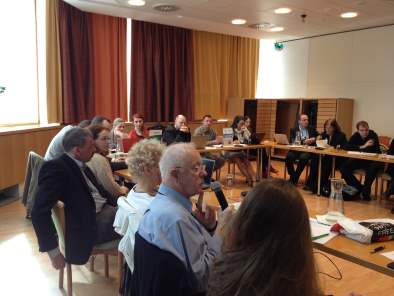The goal of the second workshop was to find connections among all activities and discuss conceptual approach. While the first workshop held in Hodrusa Hamre in October 2013 set the stage for this year, the second meeting took stock of the results achieved so far and harmonised future activities.
The workshop took place back-to-back with the Global Water Partnership Central and Eastern Europe regular Regional Council meeting. It brought together 35 participants from 10 countries – World Meteorological Organization, Global Water Partnership in Stockholm, Regional and Country Water Partnerships, Peer Review Group, Activity Leaders, partners and National Coordinators.

The participants focused on the status of implementation of Drought Management Plans and measures in the second edition of river basin management plans according to European Union Water Framework Directive. Elena Fatulova (activity leader) presented an assessment identifying gaps in the national drought management strategies in comparison to European Union strategy. This activity went hand in hand with the first round of the National Consultation Dialogues that were held in 2013 in Bulgaria, the Czech Republic, Hungary, Lithuania, Moldova, Poland, Romania, Slovakia, Slovenia and Ukraine.
The project partners shared their experiences about the National Consultation Dialogues which aimed at engaging institutions and experts from different sectors dealing with drought related issues. Henny Van Lanen of the Peer Review Group mentioned, “We need to interfere in the process of preparation at the level where we can still join the discussion. Later on, the level of discussion is on too high a level and with no power to propose or to change something”.
The participants pointed out that the actual situation in the drought management plans development is not satisfactory since many countries have not produced these plans in accordance with the guidelines in the context of the Water Framework Directive. One of the main goals of the Integrated Drought Management Programme in Central and Eastern Europe is to support countries and help them prepare drought management plans. One of the main steps towards that goal is the guidelines discussed at the workshop.
The Slovak case study, which was also presented at the workshop is one of the first concrete examples how to develop the key items of drought management plan. Examples and information from other countries will be collected during the second cycle of the National Consultation Dialogues which will be organized in the second half of the year.
Our programme is part of the global Integrated Drought Management Programme which currently develops, in cooperation with the University in Nebraska, National Drought Management Policy Guidelines. “The guidelines will be reviewed based on the regional guidelines,” pointed out Fredrik Pischke, GWP International Climate/Hydrology Officer. He also added that “the same programmes which will be soon launched in West Africa and in the Horn of Africa will benefit from experiences in Central and Eastern Europe”.
The afternoon session of the first day was divided into two separate parts. The first was a training on Drought Information Exchange Platform where experts from Drought Management Centre for South East Europe explained and demonstrated integration of national data into joint platform to all partners involved into this activity. In the second part Henny Van Lanen of the Peer Review Group presented recent achievements in drought research and science-policy interface. Lučka Kajfež Bogataj, member of a GWP Steering Committee, gave a presentation on a new Intergovernmental Panel on Climate Change reports.
During the second day, six demonstration projects were presented, covering different aspects of drought management and sectors such as water, agriculture, forestry and meteorology. “Demonstration projects are trying to go beyond physical experiments and focus on presenting the positive effects of some of the new methods”, pointed out Janusz Kindler of the Peer Review Group. The results of the demonstration projects will be published in the Good Practice Compendium, summarising the best practices from drought initiatives in other countries and regions.
In the future, the programme will focus on strengthening the cooperation between the partners and joint activities. The third IDMP CEE workshop will take place on 2-4 October 2014 in Budapest, Hungary.
Integrated Drought Management Programme in Central and Eastern Europe (IDMP CEE) supports the governments of Bulgaria, the Czech Republic, Hungary, Lithuania, Moldova, Poland, Romania, Slovakia, Slovenia and Ukraine in the development of drought management policies and plans. It also builds capacity of stakeholders at different levels for proactive integrated drought management approach and tests innovative approaches for future drought management plans.
For more information about IDMP CEE, please contact Sabina Bokal, Programme Manager, email: idmp.sabina[at]gmail.com.
Top photo: Experts discussing at the Second IDMP CEE workshop in Ljubljana, Slovenia.
Bottom photo: Experts on a field trip in Slovenia.
